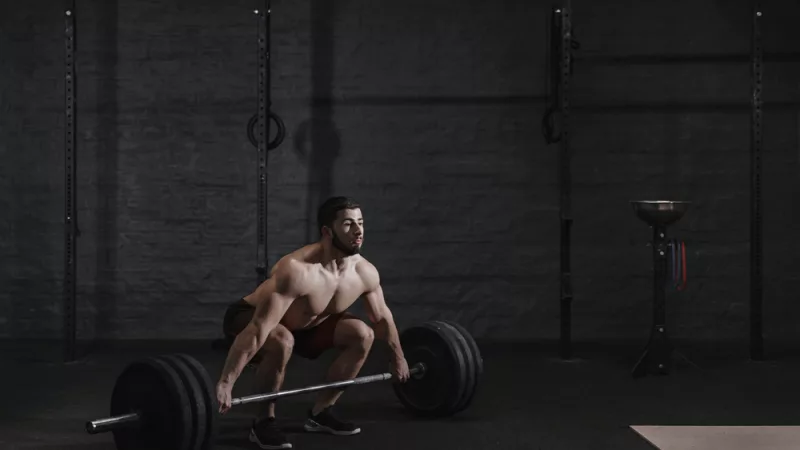The joke of skipping leg day is an old mainstay within fitness communities, and this is largely the result of leg exercises being harder to adhere to in the past. With less motility than arms, finding the right regime of easily-performed exercises for various leg muscles, especially the hamstring, can be something of a nuisance.
Today, we’re going to look at the best exercise routine for strengthening your hamstrings. Before we begin, it goes without saying that you want to balance these evenly, and never be excessive with speed, routine length, or the like. Injuring your hamstring can be excruciatingly painful, and can temporarily (or in rare cases, permanently) reduce or take away your ability to stand or walk.

How do I Know My Hamstring is Underfit?
If you already have a decent regime of general leg exercises, you may be unsure if you need to alter any of your routines to provide a better workout for your hamstrings. There are symptoms that can easily be picked up on, though.
- Cramping, Spasms, Charlie Horses – Charlie horses are very painful, uncontrolled contractions of muscles that are essentially a form of acute cramp. The most common Charlie horse that happens within the leg is in the calf muscle, or along the sole of the foot, but they can also occur in the hamstring and other upper leg muscles, if they’re not properly fit. It’s worth noting that this can also be a symptom of potassium or vitamin deficiencies as well, though if that’s the case, such problems will occur in other parts of the body as well.
- Gluteal and Upper Leg Fatigue – If walking, standing, squatting and other leg-related activities result in significant fatigue across the back of the upper leg, or the base of the gluteal area, this can be a sign that your current routines aren’t sufficiently exercising your hamstring, causing it to fatigue much more quickly than other muscle groups.
- Restless Legs – True restless leg syndrome is not what we’re talking about – that’s something that a physician should address immediately due to it being a symptom of much more severe problems than your workout routine. However, mild restlessness, which leg workouts should usually help to abate, can indicate some muscles not being properly worked, and your hamstring is a prime candidate for this.
Dangers
Let’s take a moment to talk about how important leg exercises are as a whole. On a cosmetic level, if you focus only on your upper body, you will look patently ridiculous. We’ve all seen those guys who spend all day lifting and bench pressing, but neglect their legs entirely. They look like cartoon characters!
But, on top of this, you also greatly increase your risk of knee and hamstring injuries, and these can have lasting or permanent ramifications, leaving you permanently walking with a limp, or experiencing significant pain.
It also makes squats much harder to do, as well as any practical lifting to carry or move heavier things.
Gender Doesn’t Matter
Something else we need to point out right now, is that this is just as important for women as it is for men. The same danger of leg injuries can happen if a woman’s hamstrings aren’t properly trained and well-exercised.
Equally, let’s all be honest. What kind of legs do most men prefer on a woman? Scrawny, neglected beanpoles? Or, is a woman with shapely, toned legs usually preferred? And, ladies, which would you prefer? Healthy, toned legs, or skinny, weak ones? It really matters for both sexes, equally.
You Don’t Need Crazy Equipment!
One last thing to point out, before we look at the six most effective exercises is, while having some decent equipment at your disposal does help, but you don’t need ridiculous, expensive and overwrought equipment to get a solid hamstring workout.
We live in a time that’s unrivaled historically in both fitness and nutrition sciences, as well as the elaborate equipment we can produce. This equipment is all well and good, but you really only need a few simple things, to get a full workout, including hamstring-targeting routines.
There are two routines we’ll look at that need some fitness equipment usually, but you can makeshift these if need be.
#1 – Romanian Deaflift
The Romanian deadlift is one of the simplest routines you can do. Simply hold a weighted barbell at shin level, arms straight, bending horizontally at the waist, and partially at the knee. Lift upward until your legs, waist, and arms are straight, the barbell at just below your pelvis. Hold, tightening your legs slightly, and lower back down in a controlled descent.
#2 – Barbell Back Squat
This is another simple exercise. Hold the barbell across the back of your shoulders, just at the base of the neck, elbows bent, palms outward. Have your legs apart so your feet are just past your shoulders.
Bend at the knees, outward, producing a spread-legged squat. Hold, and lift back up slowly. Remember proper squat form with this one.
#3 – Bulgarian Split Squat
This one should not be attempted by people with hip or knee trouble. Start with one leg bent at the knee, behind you on a bench. Hold weighted dumbbells at either side of your body. Bend your other leg at the knee and hip until it’s at a near sitting position, your leg on the bench at a J-like bend as a result.
Use some tension in the benched leg when returning to a standing position. Alternate between legs, evenly.
#4 – Glute-Ham Raise
This one is best served with leg press equipment. Lie face down, legs braced, cushion under your upper legs. Cross your arms across your chest, and lift yourself to a vertical position at the knees. Hold, and lower yourself back after a couple seconds. This is one of the most powerful (and fatiguing) hamstring exercises.
#5 – Leg Curl
This is the other exercise best suited with a weighted leg press. Lie face down, bracing the weighted lift just above your heels. Bend at the knee, as far as your leg and the weight will permit. Hold for about one second, and lower it back under muscle control.
#6 – Kettlebell Swing
This exercise is usually a “cooling down” or “finishing” routine, and is one of the higher kinetic impact exercises. This also works as a partial cardio exercise, so if your doctor has warned against excessive cardio, be wary of this one. Using ball weights, start bent horizontal at the waste (similar to the Romanain deadlift), the weights held back, between your legs. Bend up at the waist and the knee, swinging the weights in a parabola until your arms are almost level in front of you.
Swing back into the start position under control (don’t let inertia do it for you). Be extra careful on resuming the start position, that you don’t allow inertia to bring your arms at high speed into your groin – it doesn’t matter what your gender, that will hurt.
To learn more about hamstring exercises and other difficult group targeting routines, subscribe to my YouTube channel today. I have so many awesome things to show you!
You Might also like
-
What are The Benefits Of Deadlifts?
Did you know that deadlifts were once called “Romanian Deadlifts” and were used to test a person’s strength and character? Today, they remain a top choice for athletes, bodybuilders, and even celebrities like Dwayne “The Rock” Johnson, who credit them for building power and muscle.
This article delves beyond the hype to explore the what are the benefits of doing deadlifts, revealing the multifaceted benefits this exercise offers for both men and women, making it a valuable addition to any fitness routine.
Key Takeaways
- Deadlifts are a compound exercise that targets multiple muscle groups, offering a wide range of benefits beyond just building strength.
- They can improve athletic performance, increase bone density, enhance posture and core strength, boost metabolism, and foster mental toughness.
- Deadlifts are suitable for all fitness levels with various modifications available for beginners or those with limitations.
- Prioritizing proper form and safety is crucial to reap the benefits and avoid injuries.
Comparison Table: Conventional Deadlift vs. Sumo Deadlift
Feature Conventional Deadlift Sumo Deadlift Stance Shoulder-width apart Wider than shoulder-width Grip Overhand grip Double overhand or mixed grip Primary Muscle Groups Hamstrings, glutes, lower back Glutes, hamstrings, quads Benefits Overall strength development, improved core stability Emphasizes glute activation, suitable for individuals with limited hip mobility What are Deadlifts and How to Do Them Right:
Clear explanation: Deadlifts are a compound exercise that involves lifting a barbell off the ground from a standing position, engaging multiple muscle groups. They primarily target the hamstrings, glutes, and lower back, but also activate core muscles, shoulders, and forearms.
Step-by-step guide:
- Set up: Stand with feet shoulder-width apart, core engaged, and back straight. The barbell should be positioned in front of your shins, with hands gripping the bar slightly outside shoulder-width.
- Hinge at the hips: Keeping your back straight and core engaged, push your hips back as if you’re about to sit down. Lower the bar down your shins, maintaining a straight bar path close to your body.
- Lift with your legs: Once you feel a stretch in your hamstrings, drive through your heels to lift the bar back up to the starting position, keeping your core engaged and back straight.
- Squeeze your glutes: At the top of the movement, squeeze your glutes to fully extend your hips.
Addressing misconceptions: Deadlifts are often incorrectly labeled as dangerous for your back. However, when performed with proper form and appropriate weight, they can be a safe and effective exercise.
Remember:
- Start with lighter weights to perfect your form before increasing the load.
- Don’t round your back at any point during the movement.
- Seek guidance from a certified trainer if you’re unsure about proper form or have any pre-existing injuries.
Beyond Strength: Unveiling the Multifaceted Benefits of Deadlifts
While building strength is undeniably a key benefit of deadlifts, their true power lies in their diverse impact on overall fitness and well-being. Let’s explore some lesser-known advantages that go beyond the weight room:
- Enhanced Athletic Performance: Deadlifts are a staple exercise for athletes across various disciplines. They improve power, agility, and explosiveness by strengthening the posterior chain (glutes, hamstrings, lower back), which plays a crucial role in activities like jumping, sprinting, and changing direction quickly. A study published in the Journal of Strength and Conditioning Research found that athletes who incorporated deadlifts into their training program significantly improved their vertical jump height compared to those who didn’t.
- Increased Bone Density: Deadlifts, when performed with proper form, can stimulate bone growth and increase bone mineral density (BMD) in the lower back, hips, and spine. This is particularly beneficial for women as they are more susceptible to osteoporosis later in life. A study published in the Bone Journal showed that women who participated in a deadlift program for 12 weeks experienced significant improvements in lumbar spine BMD compared to a control group.
- Improved Posture and Core Strength: Deadlifts engage a multitude of muscle groups, including the core muscles responsible for stabilizing your spine and maintaining proper posture. By strengthening these muscles, deadlifts can help improve your posture, reducing hunching and slouching, and leading to better overall body alignment. A 2018 study in the Journal of Sports Science and Medicine found that deadlift training led to significant improvements in both postural awareness and core strength in healthy adults.
- Boosted Metabolism and Calorie Burning: Deadlifts are a compound exercise that activates multiple muscle groups simultaneously, leading to a higher metabolic demand compared to isolation exercises. This increased metabolic activity translates to burning more calories, even at rest, which can be beneficial for weight management and overall fitness goals. A study published in the Journal of Applied Physiology found that deadlifts resulted in a significantly higher post-exercise oxygen consumption (EPOC) compared to other exercises, indicating a greater calorie burn even after the workout is complete.
- Mental Toughness and Confidence: Mastering a challenging exercise like the deadlift can be incredibly rewarding, fostering a sense of accomplishment and boosting confidence in your physical capabilities. This mental toughness translates to other areas of life, teaching perseverance and resilience in the face of challenges.
Remember: These benefits are not just for men! Deadlifts offer a wide range of advantages for benefits of deadlifts for females as well. Numerous studies and personal experiences of female athletes and fitness enthusiasts highlight the positive impact of deadlifts on strength, athletic performance, and overall well-being.
what muscles do deadlifts target
- Gluteus Maximus: (Butt)
- Quadriceps: (Upper Front legs)
- Adductor Magnus: (Inner Thigh)
- Soleus: (Smaller part of your calf muscle)
- Hamstrings: (Upper back of legs)
- Gastrocnemius: (bigger part of your calf muscle)
- Erector Spinae: (lower back)
- Trapezius, upper: (upper neck muscles)
- Trapezius, middle: (middle neck muscles)
- Levator Scapulae: (the muscle from your jaw to your shoulder)
- Rhomboids: ( upper inner back muscles right below your neck)
- Rectus Abdominis: (abs)
- Obliques: (side abs)
Variations for All Levels
The beauty of deadlifts lies in their versatility. While the conventional deadlift is a fantastic exercise, there are numerous variations that cater to different fitness levels, goals, and individual needs. Here are a few popular variations:
-
Romanian Deadlifts (RDLs):
-
- Purpose: Primarily target the hamstrings and glutes, emphasizing hip hinge movement.
- Benefits: Excellent for developing hamstring flexibility and building lower body strength without straining the lower back. Suitable for beginners or those working on proper form.
- Progression: Start with bodyweight or light dumbbells and gradually increase the weight as your form and hamstring flexibility improve.
-
Sumo Deadlifts:
-
- Purpose: Targets the glutes and hamstrings while placing less stress on the lower back and core due to a wider stance.
- Benefits: Ideal for individuals with limited hip mobility or those looking to emphasize glute activation.
- Progression: Similar to conventional deadlifts, begin with lighter weights and focus on proper form before increasing the load.
-
Trap Bar Deadlifts:
-
- Purpose: Offers a more neutral grip position, potentially reducing strain on the wrists and forearms compared to the conventional deadlift.
- Benefits: Suitable for individuals with wrist or forearm limitations or those who prefer a more comfortable grip.
- Progression: Follow the same progression principles as the conventional deadlift, starting with light weights and gradually increasing the load as your strength improves.
Remember: These are just a few examples, and numerous other deadlift variations exist. It’s crucial to choose variations that align with your individual goals and limitations. Always prioritize proper form over weight, and don’t hesitate to seek guidance from a certified trainer if needed.
As you progress in your deadlift journey, you can safely transition between variations once you’ve mastered the basic movement patterns. Start with bodyweight or lighter weights for any new variation, focusing on proper form and technique before gradually increasing the load. Remember, consistency and proper form are key to unlocking the full potential of deadlifts and reaping their numerous benefits.
Safety First: Essential Precautions and Tips
Unlocking the full potential of deadlifts hinges on prioritizing proper form and safety. Remember, a well-executed deadlift with lighter weights is far more beneficial than attempting heavier weights with compromised form.
-
Mastering the Form is Paramount:
-
- Visuals are Key: Consider incorporating instructional videos or detailed images demonstrating proper form throughout the deadlift movement. This can significantly improve understanding and execution.
Seek Guidance: If you’re unsure about any aspect of the movement, don’t hesitate to consult a certified personal trainer or coach. They can provide personalized guidance and ensure you’re performing the exercise safely and effectively.
- Visuals are Key: Consider incorporating instructional videos or detailed images demonstrating proper form throughout the deadlift movement. This can significantly improve understanding and execution.
-
Warm-up and Cool-down are Non-Negotiable:
-
- Dynamic Warm-up: Before diving into deadlifts, engage in a dynamic warm-up routine that includes activities like light cardio, lunges, arm circles, and dynamic stretches. This prepares your body for movement and increases blood flow to your muscles, reducing the risk of injury.
- Static Cool-down: After your deadlift workout, don’t neglect a static cool-down routine. This includes stretches that target the major muscle groups involved in the exercise, such as your hamstrings, glutes, lower back, and core. This helps improve flexibility, reduce muscle soreness, and promote recovery.
-
3. Listen to Your Body:
-
- Start Light, Go Slow: Always begin with lighter weights, even if it feels easier than you anticipated. This allows you to focus on proper form and technique before progressively increasing the weight as your strength and confidence improve.
- Prioritize Form Over Weight: It’s tempting to push yourself and lift heavier weights, but remember, proper form is paramount. Lifting heavier weights with compromised form significantly increases the risk of injury. Don’t be afraid to reduce the weight if necessary to maintain perfect form throughout the movement.
- Respect Your Limits: Pay close attention to your body’s signals. If you experience any pain or discomfort, stop the exercise immediately. Consult a healthcare professional if the pain persists.
-
Seek Professional Guidance:
- Pre-existing Injuries: If you have any pre-existing injuries or limitations that might affect your ability to perform deadlifts safely, it’s crucial to consult a certified personal trainer or physical therapist. They can assess your individual needs and recommend modifications or alternative exercises that are safe and effective for you.
By prioritizing safety and incorporating these essential tips into your deadlift routine, you can ensure a rewarding and injury-free experience while reaping the numerous benefits this powerful exercise offers.
6 FAQs About Deadlifts
-
Are deadlifts dangerous?
- Deadlifts can be safe when performed with proper form and appropriate weight. However, improper form can increase the risk of injury. It’s crucial to prioritize form and seek guidance from a certified trainer if needed.
-
Can women benefit from deadlifts?
- Absolutely! Deadlifts offer numerous benefits for women, including improved strength, athletic performance, bone density, and overall fitness.
-
What are some common deadlift mistakes?
- Rounding the back, lifting with the legs instead of the hips, and using excessive weight are common mistakes that can lead to injury.
-
How often should I do deadlifts?
- The frequency depends on your individual fitness level and goals. Beginners can start with once or twice a week, while experienced individuals can perform them more frequently.
-
What are some good deadlift alternatives?
- If deadlifts are not suitable for you due to limitations or injuries, consider alternative exercises like Romanian deadlifts, lunges, or squats.
-
What are the best deadlift variations for beginners?
- Bodyweight deadlifts, Romanian deadlifts with light dumbbells, and sumo deadlifts with lighter weights are excellent options for beginners to learn proper form and build confidence.
Conclusion: Unleash Your Potential with Deadlifts
Deadlifts have rightfully earned their reputation as a powerhouse exercise. They go beyond building raw strength, offering a multitude of benefits that can significantly enhance your overall fitness and well-being. From improved athletic performance and increased bone density to enhanced posture, boosted metabolism, and mental toughness, deadlifts offer a well-rounded package for individuals of all fitness levels.
Ready to incorporate deadlifts into your workout routine? Even beginners can reap the rewards! Start with bodyweight or lighter weights, prioritize proper form above all else, and gradually increase the load as your strength and confidence improve. Remember, numerous variations exist, so don’t hesitate to explore and find the variation that best suits your needs and limitations.
Embrace the challenge of deadlifts. They may not be easy, but the journey of mastering this exercise and unlocking its potential is an empowering and rewarding experience. So, unleash your inner champion, embrace the power of deadlifts, and watch your fitness journey soar to new heights!
-
Transforming Your Health Passion Into Impactful Initiatives
In a landscape where health is of paramount importance, the impulse to channel your fervor for health and well-being into something meaningful should not be underestimated. RunThaCity delves into diverse ways to transform your enthusiasm into impactful initiatives. From the altruistic undertakings of volunteering to the entrepreneurial aspirations of starting a health-focused business, multiple paths can lead to noteworthy contributions to public health.Volunteer Your Services
Volunteering serves as an effective channel for converting your health-related enthusiasm into palpable change. Opportunities abound in this sector, from offering your skills in local healthcare facilities to participating in outreach programs within the community. The act of volunteering not only offers tangible support to healthcare operations but also presents a window into the transformative power of your passion as you witness first-hand the positive effect it can have on individual lives.Find a Job in the Field
In the quest to find a job that supports people’s health, it’s essential to present yourself as the ideal candidate who can make a positive impact in the healthcare industry or wellness sector. Before seeking such a meaningful position, ensure your first impression is impactful by creating a stellar and professional-looking resume online. Utilizing a free online resume template allows you to select from a library of professionally designed templates, tailored to reflect the compassion and professionalism required in health-supportive roles. These templates provide a foundation upon which you can add your own personal touch—inserting copy, photos, colors, and images that represent your commitment to enhancing people’s health. Crafting your resume online with these customizable options ensures you stand out as a dedicated professional ready to contribute to the wellbeing of others.Become a Health Entrepreneur
Taking an entrepreneurial approach can be a fulfilling way to marry your passion with business. Launching a business in this field isn’t just a passionate endeavor — it necessitates a strategic mindset. Vital elements include devising an insightful business plan and performing comprehensive market analysis, all aimed at ensuring the long-term success and societal impact of your venture.Share Your Health Knowledge
The currency of knowledge is especially valuable in the health sector. Employ various platforms to disseminate essential information, whether through digital avenues such as blogs and social media or more traditional methods like workshops and public talks. The sharing of credible information supports societal well-being, elevating the public’s understanding of health matters and influencing their decisions in a positive manner.Pursue Healthcare Careers
Choosing a formal career in healthcare or wellness opens doors to not only fulfilling personal ambitions but also making a lasting, positive impact on society. Whether one is a nurse attending to patients’ immediate needs, a chef guiding people towards healthier living, a therapist helping individuals manage emotional or physical challenges or a public health professional designing programs for community well-being, each role serves as a touchstone for lasting change. What sets these careers apart is the ability to offer meaningful improvement in the health and lives of individuals and communities, thereby fulfilling both professional and altruistic goals.Fundraise for Health Causes
Financial resources are a cornerstone for many health-related programs and research initiatives. Efforts to raise these funds can range from organizing charity events and community drives to launching crowdfunding campaigns. Through fundraising, you have the potential to accelerate research, facilitate healthcare delivery, and support medical interventions, leaving an indelible imprint on health-related endeavors.Become a Health Advocate
Policy advocacy holds the power to enact sweeping changes that can affect millions. Utilize your enthusiasm for health to campaign for transformative policies that address healthcare accessibility, preventive health measures, and social disparities in healthcare. Align yourself with organizations dedicated to these causes, and use your influence to sway public opinion and legislative decisions. Channeling your enthusiasm for health into meaningful contributions is not only commendable but also impactful. Through varied paths — whether volunteering, initiating a business, sharing valuable knowledge, etc. — you contribute to a tapestry of improved health and well-being for the community and society at large. Each of these avenues offers unique rewards and challenges but holds in common the potential for significant, enduring impact. Through these endeavors, you help shape a world that is not only healthier but also more aware and proactive in its approach to well-being. At RunThaCity, we believe that fitness and sportbikes are not just hobbies, but a way of life. Visit our website to learn more about both today!SelfCaring.info
Brad, is a guest contributor for RunThaCity.com. He is passionate about empowering individuals to reach their full potential through self-care.
Brad's expertise stems from his personal journey and a genuine desire to help people flourish. He now shares his insights through [link to selfcaring.info, if available] and various guest posting opportunities.
-
Over 100 Motivational Fitness Quotes With Images
Are you looking for the perfect motivation quote, meme, or image? Click to find the perfect one for your day! Feel free to download, share, etc!!










